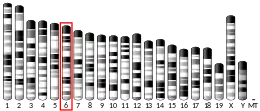KLRB1
گیرندهٔ شبه لکتینی سلول کُشنده، خانوادهٔ B عضو ۱ (انگلیسی: Killer cell lectin-like receptor subfamily B, member 1) که با نامهای NK1.1 و CD161 هم شناخته میشوند، یک پروتئین است که در انسان توسط ژن «KLRB1» کُدگذاری میشود.[4]
| KLRB1 | |||||||||||||||||||||||||
|---|---|---|---|---|---|---|---|---|---|---|---|---|---|---|---|---|---|---|---|---|---|---|---|---|---|
| معینکنندهها | |||||||||||||||||||||||||
| نامهای دیگر | KLRB1, CD161, CLEC5B, NKR, NKR-P1, NKR-P1A, NKRP1A, hNKR-P1A, killer cell lectin like receptor B1 | ||||||||||||||||||||||||
| شناسههای بیرونی | OMIM: 602890 MGI: 107540 HomoloGene: 84369 GeneCards: KLRB1 | ||||||||||||||||||||||||
| |||||||||||||||||||||||||
| |||||||||||||||||||||||||
| |||||||||||||||||||||||||
| همساختشناسی | |||||||||||||||||||||||||
| گونهها | انسان | موش | |||||||||||||||||||||||
| Entrez | |||||||||||||||||||||||||
| آنسامبل | |||||||||||||||||||||||||
| یونیپروت | |||||||||||||||||||||||||
| RefSeq (mRNA) | |||||||||||||||||||||||||
| RefSeq (پروتئین) | |||||||||||||||||||||||||
| موقعیت (UCSC) | n/a | Chr : 128.61 – 128.62 Mb | |||||||||||||||||||||||
| جستجوی PubMed | [2] | [3] | |||||||||||||||||||||||
| ویکیداده | |||||||||||||||||||||||||
| |||||||||||||||||||||||||
سلولهای کشنده طبیعی، لنفوسیتهایی هستند که با ترشح سیتوکینها پس از تحریک سیستم ایمنی بدن، کشتار سلولی را سبب میشود. چندین ژن از خانوادهٔ بزرگ لکتینهای نوع سی و از جمله ژنها و گلیکوپروتئینهای KLRA1 در جوندگان در سلولهای کشنده طبیعی بیان میشود و در تنظیم عملکرد آنان نقش دارند.
منابع
- GRCm38: Ensembl release 89: ENSMUSG00000030361 - Ensembl, May 2017
- "Human PubMed Reference:". National Center for Biotechnology Information, U.S. National Library of Medicine.
- "Mouse PubMed Reference:". National Center for Biotechnology Information, U.S. National Library of Medicine.
- "Entrez Gene: KLRB1 killer cell lectin-like receptor subfamily B, member 1".
- مشارکتکنندگان ویکیپدیا. «KLRB1». در دانشنامهٔ ویکیپدیای انگلیسی، بازبینیشده در ۲۹ دسامبر ۲۰۱۹.
برای مطالعهٔ بیشتر
- Smith FB, Connor JM, Lee AJ, Cooke A, Lowe GD, Rumley A, Fowkes FG (2004). "Relationship of the platelet glycoprotein PlA and fibrinogen T/G+1689 polymorphisms with peripheral arterial disease and ischaemic heart disease". Thrombosis Research. 112 (4): 209–16. doi:10.1016/j.thromres.2003.11.010. PMID 14987913.
- Lanier LL, Chang C, Phillips JH (September 1994). "Human NKR-P1A. A disulfide-linked homodimer of the C-type lectin superfamily expressed by a subset of NK and T lymphocytes". Journal of Immunology. 153 (6): 2417–28. PMID 8077657.
- Poggi A, Costa P, Morelli L, Cantoni C, Pella N, Spada F, Biassoni R, Nanni L, Revello V, Tomasello E, Mingari MC, Moretta A, Moretta L (June 1996). "Expression of human NKRP1A by CD34+ immature thymocytes: NKRP1A-mediated regulation of proliferation and cytolytic activity". European Journal of Immunology. 26 (6): 1266–72. doi:10.1002/eji.1830260613. PMID 8647203.
- Renedo M, Arce I, Rodríguez A, Carretero M, Lanier LL, López-Botet M, Fernández-Ruiz E (1997). "The human natural killer gene complex is located on chromosome 12p12-p13". Immunogenetics. 46 (4): 307–11. doi:10.1007/s002510050276. PMID 9218532.
- Poggi A, Costa P, Zocchi MR, Moretta L (September 1997). "Phenotypic and functional analysis of CD4+ NKRP1A+ human T lymphocytes. Direct evidence that the NKRP1A molecule is involved in transendothelial migration". European Journal of Immunology. 27 (9): 2345–50. doi:10.1002/eji.1830270932. PMID 9341779.
- Poggi A, Rubartelli A, Moretta L, Zocchi MR (November 1997). "Expression and function of NKRP1A molecule on human monocytes and dendritic cells". European Journal of Immunology. 27 (11): 2965–70. doi:10.1002/eji.1830271132. PMID 9394825.
- Poggi A, Costa P, Tomasello E, Moretta L (May 1998). "IL-12-induced up-regulation of NKRP1A expression in human NK cells and consequent NKRP1A-mediated down-regulation of NK cell activation". European Journal of Immunology. 28 (5): 1611–6. doi:10.1002/(SICI)1521-4141(199805)28:05<1611::AID-IMMU1611>3.0.CO;2-6. PMID 9603467.
- Carlyle JR, Martin A, Mehra A, Attisano L, Tsui FW, Zúñiga-Pflücker JC (May 1999). "Mouse NKR-P1B, a novel NK1.1 antigen with inhibitory function". Journal of Immunology. 162 (10): 5917–23. PMID 10229828.
- Ishihara S, Nieda M, Kitayama J, Osada T, Yabe T, Ishikawa Y, Nagawa H, Muto T, Juji T (August 1999). "CD8(+)NKR-P1A (+)T cells preferentially accumulate in human liver". European Journal of Immunology. 29 (8): 2406–13. doi:10.1002/(SICI)1521-4141(199908)29:08<2406::AID-IMMU2406>3.0.CO;2-F. PMID 10458753.
- Iiai T, Watanabe H, Suda T, Okamoto H, Abo T, Hatakeyama K (July 2002). "CD161+ T (NT) cells exist predominantly in human intestinal epithelium as well as in liver". Clinical and Experimental Immunology. 129 (1): 92–8. doi:10.1046/j.1365-2249.2002.01886.x. PMC 1906419. PMID 12100027.
- Iizuka K, Naidenko OV, Plougastel BF, Fremont DH, Yokoyama WM (August 2003). "Genetically linked C-type lectin-related ligands for the NKRP1 family of natural killer cell receptors". Nature Immunology. 4 (8): 801–7. doi:10.1038/ni954. PMID 12858173.
- Carlyle JR, Jamieson AM, Gasser S, Clingan CS, Arase H, Raulet DH (March 2004). "Missing self-recognition of Ocil/Clr-b by inhibitory NKR-P1 natural killer cell receptors". Proceedings of the National Academy of Sciences of the United States of America. 101 (10): 3527–32. doi:10.1073/pnas.0308304101. PMC 373496. PMID 14990792.
- Aldemir H, Prod'homme V, Dumaurier MJ, Retiere C, Poupon G, Cazareth J, Bihl F, Braud VM (December 2005). "Cutting edge: lectin-like transcript 1 is a ligand for the CD161 receptor". Journal of Immunology. 175 (12): 7791–5. doi:10.4049/jimmunol.175.12.7791. PMID 16339512.
- Rosen DB, Bettadapura J, Alsharifi M, Mathew PA, Warren HS, Lanier LL (December 2005). "Cutting edge: lectin-like transcript-1 is a ligand for the inhibitory human NKR-P1A receptor". Journal of Immunology. 175 (12): 7796–9. doi:10.4049/jimmunol.175.12.7796. PMID 16339513.
- Pozo D, Valés-Gómez M, Mavaddat N, Williamson SC, Chisholm SE, Reyburn H (February 2006). "CD161 (human NKR-P1A) signaling in NK cells involves the activation of acid sphingomyelinase". Journal of Immunology. 176 (4): 2397–406. doi:10.4049/jimmunol.176.4.2397. PMID 16455998.
- Christiansen D, Mouhtouris E, Milland J, Zingoni A, Santoni A, Sandrin MS (September 2006). "Recognition of a carbohydrate xenoepitope by human NKRP1A (CD161)". Xenotransplantation. 13 (5): 440–6. doi:10.1111/j.1399-3089.2006.00332.x. PMID 16925668.
- Rosen DB, Cao W, Avery DT, Tangye SG, Liu YJ, Houchins JP, Lanier LL (May 2008). "Functional consequences of interactions between human NKR-P1A and its ligand LLT1 expressed on activated dendritic cells and B cells". Journal of Immunology. 180 (10): 6508–17. doi:10.4049/jimmunol.180.10.6508. PMC 2577150. PMID 18453569.
This article is issued from Wikipedia. The text is licensed under Creative Commons - Attribution - Sharealike. Additional terms may apply for the media files.



